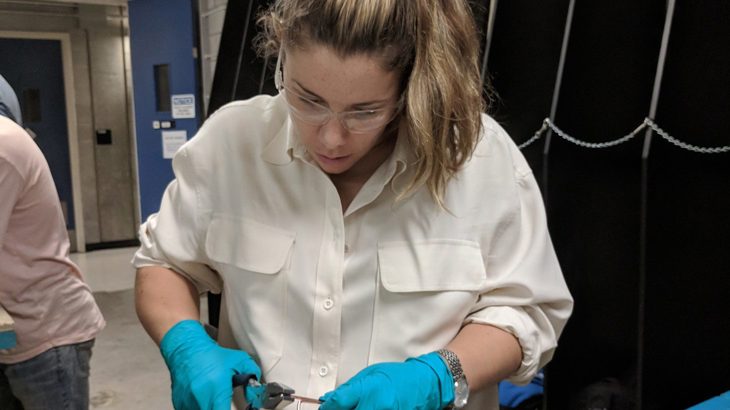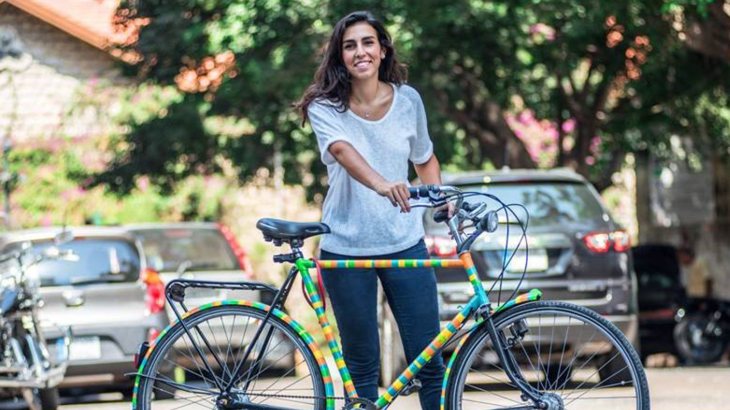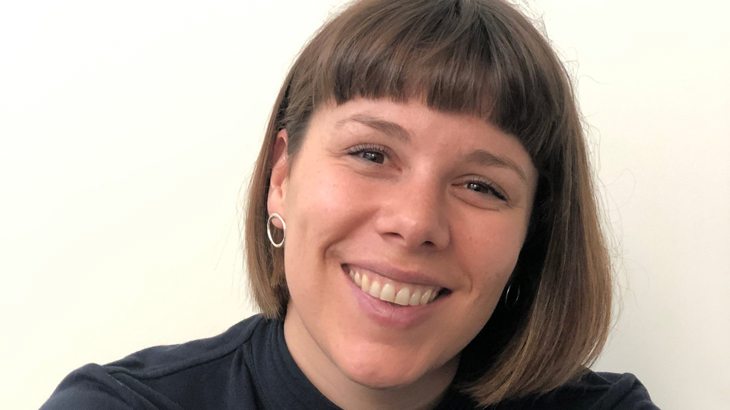The UK has the lowest percentage of female engineers in Europe, at 11%. At Sustrans, we advocate the needs and benefits of creating diverse and inclusive streets and places for everyone. But for that to happen, the industry needs to step up and attract more women.

Zeina Hawa (pictured right) believes that due to the pandemic we now have an opportunity to rethink our public spaces and redesign them to work better for people.
To celebrate International Women in Engineering Day, we chat with two of our colleagues in London about their work and why they chose engineering as a career.
Suzanne King, known to colleagues and friends as Suz, is an Engineer at Sustrans London.
Originally from Canada, Suz completed her studies at the University of British Columbia in Vancouver, with an exchange term at TU Delft in the Netherlands.
Zeina Hawa is an Engineer at Sustrans London. Originally from Lebanon, Zeina completed her studies at University College London.
What inspired you about engineering?
Suz: I was initially inspired to get into civil engineering through my interest in water resources.
I completed a research project on water sovereignty in Singapore, which opened my eyes to the overlap between society, economics, politics, and the built environment.
I found that engineering was a career that did not pigeon-hole me into a certain area, but rather allow me to explore many important fields.
Engineering is essentially a mix of art and science and there are so many options that come with this, and endless opportunities to make a positive impact on society.
Zeina: I was always interested in both arts and science at school, and so I saw engineering as a way for me to be able to combine lots of things I love – working with people and creating art.
Engineering is ultimately about how we can make things better.
It's often perceived as on the other end of the spectrum as the arts. But for me, it’s really not. And there is beautiful art and elegance in solving problems well.
Engineering is also a career that enables you to make a difference and contribute to the world in a tangible way.
It’s not just about sitting in front of a computer and punching in equations, but rather working with people and improving the quality of life and wellbeing of communities.
What was the most exciting project you’ve worked on?
Suz: Throughout my career, I worked on a number of exciting assignments.
These included the chance to manage my own SuDs (Sustainable Urban Drainage) project with the multinational engineering firm, AECOM.
From project inception to design and construction, I designed a series of rain gardens that have now be installed and are working to treat and collect road water run-off.
This works to prevent road flooding, enhance habitats and encourage community ownership and maintenance.
It is exciting to see your ideas and designs working in real life!
Zeina: Whilst my career has enabled me to be a part of a wide range of fascinating work, I still think the most interesting engineering project I’ve worked on was during the first year of my undergraduate degree.
We had to design and build a child’s toy. Whilst it may sound like a simple project – which it did to me initially – it was actually really interesting.
And it was great to experience building something with minimal materials and skills, and testing things out in reality.
It was the ideal combination of problem solving and design, and really captured the essence of engineering for me.

Suz's current work focusses on responding to the Covid-19 pandemic by designing emergency pop-up cycle lanes, school streets and low traffic neighbourhoods.
What are you currently working on?
Suz: Most of my work at the moment is responding to the Covid-19 pandemic by designing emergency pop-up cycle lanes, school streets and low traffic neighbourhoods.
We have a big opportunity now to prevent a rise in car use as lockdown eases, and I hope that our work will help people to walk and cycle more.
Other projects include the analysis of the existing and proposed cycle network in the London Borough of Redbridge to help improve the connectivity of the borough.
And some design proposals for a fun and colourful park outside of a nursing home in Harrow.
Zeina: Due to the Covid-19 pandemic, most of my work recently has been focused on temporary infrastructure, and specifically pop-up cycle lanes in the London borough of Enfield and also in Scotland.
It has really highlighted how for so long our public spaces have been built with cars in mind.
We now have an opportunity to rethink our public spaces and redesign them to work better for people.
I’ve also been working quite a lot on School Streets, as schools gear up to return at full capacity in September.
We’ve been working on ways to create more child-friendly environments outside of schools that work to improve air quality and allow more space for children and parents to socially distance.
How has the Covid-19 pandemic affected your work? Did you come up with any solutions to mitigate the impact?
Zeina: Our work has really accelerated during the pandemic.
Conversations about what our streets should look like have reached the mainstream, and it’s been a real opportunity to bring our work to life.
We’ve had to think more immediately and creatively about solutions, but overall we’re positive about the impact we can make during this time of crisis for better places for people to live and work.
How can engineering bring value to our public spaces?
Suz: Engineering can be used in so many different ways. It’s really about the ability to think critically and creatively problem solve.
Working at Sustrans allows me to focus that creative and technical expertise toward bringing value to people in their local environment.
We focus on what people want and engage with a broad range of communities to inform our design.
We design for people of all ages and abilities and create urban spaces that are welcoming for all. And that is what I really love about working at Sustrans!
Zeina: Engineering is in every aspect of our built environment, and it’s easy to notice a space that is badly designed, as it creates discomfort for people.
The engineering work we do at Sustrans is all about creating better living environments for everyone, by improving safety, social interaction and play.
The places in which we move around can impact both our physical and mental health, and so good engineering is essential to the wellbeing of the people and communities using the space.

Zeina: "In order to get more women into engineering, I think it’s important to highlight more females in engineering right now. Women don’t have many role models in the field."
The UK has the lowest percentage of female engineers in the whole of Europe. Why is this so? What do you think is needed to get more women into engineering?
Zeina: In Lebanon, where I grew up, engineering is seen as a prestigious field, in line with Law and Medicine, and so both men and women are actively encouraged to access these fields.
Based on my time spent in the UK, it seems that this conception of engineering is less prominent, and so this may be one reason.
In order to get more women into engineering, I think it’s important to highlight more females in engineering right now.
Women don’t have many role models in the field and so it is essential that we celebrate those currently doing the work.
It’s also really important to diversify what engineering means and how it is perceived, and really highlight how creative, dynamic and broad it can be.
More grassroots work is needed in the early years of schools in order to break gender stereotypes.
If we can encourage girls to see themselves as being able to access typically male-dominated careers from a young age, I feel like we will see more women entering the field in the future.
Suz: So much more needs to be done to encourage women to get into engineering, including more exposure to the field at a younger age through workshops and camps, and embedding it into the curriculum.
There needs to be more of an effort to display the variety of opportunities and careers available to engineers.
People often think of engineering as being all about hard science and maths, but it’s so much more than that.
It’s about creativity. It’s important that we communicate this better, in order to attract a wider range of people into the field.
It wasn’t until I spend my term in Delft that I realized the wide scope of engineering in general, and within civil engineering as well.
In the Netherlands, there is little stigma around females in engineering and it dispelled the myth of what the ‘typical engineer’ is perceived as.
Why do we need more women in engineering?
Suz: Engineering has been dominated by white males and that has inherently resulted in an urban realm that is designed for white males
This must change. Having more women in engineering will help diversify perspectives and approaches to problem-solving, and effectively design for diverse communities.
The industry should also be more inclusive of people from BAME backgrounds.
Zeina: At least in public spaces and the built environment, women navigate and interact with streets and spaces differently.
They have different considerations and preferences, and it’s really important to bring all of these views into the conversation and decision-making.
It is also important to remember that women are not one group in themselves, but rather an intersection of people who experience the world in different ways based on a number of factors.
To reflect how different people navigate the built environment, the voices of all groups need to be heard.
This will create more innovative solutions and identify things that certain groups may see as an issue but others don’t, and therefore create fairer and more inclusive spaces.

Suz: "Engineering has been dominated by white males and that has inherently resulted in an urban realm that is designed for white males. This must change."
What advice would you give organisations looking to hire an engineer?
Suz: One thing that really impressed me about Sustrans, and something I think more organisations need to utilise, is a stripped application procedure.
This means that the hiring managers are not given any information on the applicant that may reveal inherent biases, such as the candidate's name and CV.
Instead, they are given a selection of questions that the candidate has answered.
What advice would you give to girls and young women who are considering their career choices right now?
Zeina: Engineering can be a really creative and dynamic career.
However, there are many misconceptions that make people believe it’s all rooted in technicalities. It’s a really broad field that offers so much potential.
Design and problem-solving play a huge role in engineering so if these are things of interest to you, go for it!





